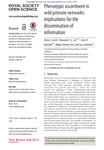Please use this identifier to cite or link to this item:
http://lib.hpu.edu.vn/handle/123456789/22390Full metadata record
| DC Field | Value | Language |
|---|---|---|
| dc.contributor.author | Carter, Alecia J. | en_US |
| dc.contributor.author | Lee, Alexander E. G. | en_US |
| dc.contributor.author | Marshall, Harry H. | en_US |
| dc.date.accessioned | 2016-07-30T01:39:19Z | |
| dc.date.available | 2016-07-30T01:39:19Z | |
| dc.date.issued | 2015 | en_US |
| dc.identifier.other | HPU4160494 | en_US |
| dc.identifier.uri | https://lib.hpu.edu.vn/handle/123456789/22390 | en_US |
| dc.description.abstract | Individuals’ access to social information can depend on their social network. Homophily—a preference to associate with similar phenotypes—may cause assortment within social networks that could preclude information transfer from individuals who generate information to those who would benefit from acquiring it. Thus, understanding phenotypic assortment may lead to a greater understanding of the factors that could limit the transfer of information between individuals | en_US |
| dc.format.extent | 13 p. | en_US |
| dc.format.mimetype | application/pdf | en_US |
| dc.language.iso | en | en_US |
| dc.subject | Biology | en_US |
| dc.subject | Behaviour | en_US |
| dc.subject | Ecology | en_US |
| dc.subject | Social network | en_US |
| dc.subject | Social information | en_US |
| dc.subject | Phenotypic assortment | en_US |
| dc.title | Phenotypic assortment in wild primate networks | en_US |
| dc.type | Article | en_US |
| dc.size | 934KB | en_US |
| dc.department | Education | en_US |
| Appears in Collections: | Education | |
Files in This Item:
| File | Description | Size | Format | |
|---|---|---|---|---|
| 0377_Phenotypicassortment.pdf Restricted Access | 934.75 kB | Adobe PDF |  View/Open Request a copy |
Items in DSpace are protected by copyright, with all rights reserved, unless otherwise indicated.
